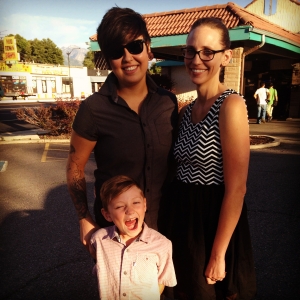As our children grow up, it can sometimes feel as if they’re growing away from us. We know they need to spread their wings, find themselves, and cut the apron strings, but that doesn’t stop us from feeling a little sting the first time we realize they don’t want to be seen with us at the mall.
The separation process continues as they develop their own interests and pursuits, many times going in very different directions from the well-intentioned road map we carefully created for them.
The teen years blow in, bringing the discomfort of change we’re not ready for: a sudden disinterest in family vacations, less time with family and more time with friends, and a dislike for shared activities that were enjoyable just yesterday.
I remember the day my teenage daughter and I were rock climbing together as we had many times before, and she announced that she didn’t want to climb any more. My response was, “Do you mean today?”
As they become adults and we grow older—differences can become more pronounced. Belief systems, lifestyles, parenting styles, political views: sometimes these big hitters resemble our own, but many times not. The differences between our adult children and ourselves can quickly pile into a wall that sits between us. But it doesn’t have to.
Here are five tips for bringing you and your adult children back together:
Find common ground. Everyone has to eat. Make it a point to share a meal together regularly. Put it on your calendar as you would any other important engagement. Make a date and try a new restaurant together, or meet for coffee. Focus on the interests you still share.
My daughter and I both still love music. Some of my best memories with her involve going to concerts, browsing through music stores, and listening to her play the guitar. We’re avid readers and can spend hours in the bookstore together. Think back to some of your best memories with your children and recapture those shared interests as adults.
Explore your differences. You’re a republican; your son is a democrat. My daughter is a vegan; I’m not. What better way to learn about our children than to talk to them about what’s “different.” Ask questions. Do a little research. Create a safe place for conversation.
I understand the difference between “vegetarian” and “vegan,” I have a vegan cookbook, and I’ve eaten at several incredible vegan restaurants that I would have otherwise missed out on. Even if you don’t agree with your child’s views, you can still express interest and learn enough to engage in conversation.
Stay in touch. Whether you live in different states or the same city, technology makes it very easy to stay connected despite busy schedules. SKYPE, FaceTime, email, and yes—texting—all add a little ease to communicating when free time is scarce. Being able to send photos and little messages back and forth creates a familiarity with everyday life.
I love old-fashioned letter writing and cards, and since a recent move means I’m nine hours from my daughter and her family, I’ve added that into our communication mix. A girlfriend told me today that her mom is in her mid-seventies, in another state, and they play Words With Friends every night for a few minutes. The medium isn’t important, but what is important is connecting on a regular basis.
Give a little. The holidays come to mind, but I’m not talking about gifts; I’m talking about flexibility. Adult children have partners, spouses, their own children, and in-laws. Trying to make everyone happy in this scenario is impossible. Don’t add to the chaos of holiday scheduling by making demands. If scheduling interferes with old traditions, create new ones. Offer to be the one who travels, take the opportunity to babysit grandchildren while the parents buy gifts, or celebrate the holiday a few days early or late. The most important thing is being together and creating memories—not stress.
Invest the effort. Your relationship with your adult child is like any other relationship; you have to mindfully invest. Keeping your lives connected isn’t going to just happen; you have to make it happen. Recognize that you’re in different seasons of life and work around that with realistic expectations. My daughter is a stepmom to an 8-year old, and both parents are in school and work fulltime. I know from experience that the season she’s in is far more hectic and busy than mine, so I take the lead in planning.
Take a vacation together, maybe one that falls outside the regular holidays so it’s less stressful for everyone. Whether you’re sitting on the sidelines watching your grandchild play soccer, taking a road trip, or grabbing a quick cup of coffee—be thoughtful and deliberate about spending time together.
Differences don’t have to turn into distance. There will always be common ground to till and nurture. With blooms starting to unfold in the warmth of spring, be reminded that roots tend to grow deepest where conditions are most favorable. This is the season of newness and fresh starts; take the first step, and reconnect with those treasures whose beginnings had their start with you.
 Peggy Bodde left her corporate position as Senior Vice President of an outdoor company in Utah last year to pursue her writing career full-time. To add to the excitement of a midlife career change at age 48, she also decided to marry the love of her life and move to Colorado. Her daughter, Lauren, is 26 and lives in Utah with her stepson and lovely wife. Becoming a midlife grandma has proven to be incredibly fun. Peggy has a passion for mentoring women in business, pursues her faith recklessly, and loves fly-fishing with her husband on faraway rivers whenever life permits.
Peggy Bodde left her corporate position as Senior Vice President of an outdoor company in Utah last year to pursue her writing career full-time. To add to the excitement of a midlife career change at age 48, she also decided to marry the love of her life and move to Colorado. Her daughter, Lauren, is 26 and lives in Utah with her stepson and lovely wife. Becoming a midlife grandma has proven to be incredibly fun. Peggy has a passion for mentoring women in business, pursues her faith recklessly, and loves fly-fishing with her husband on faraway rivers whenever life permits.

